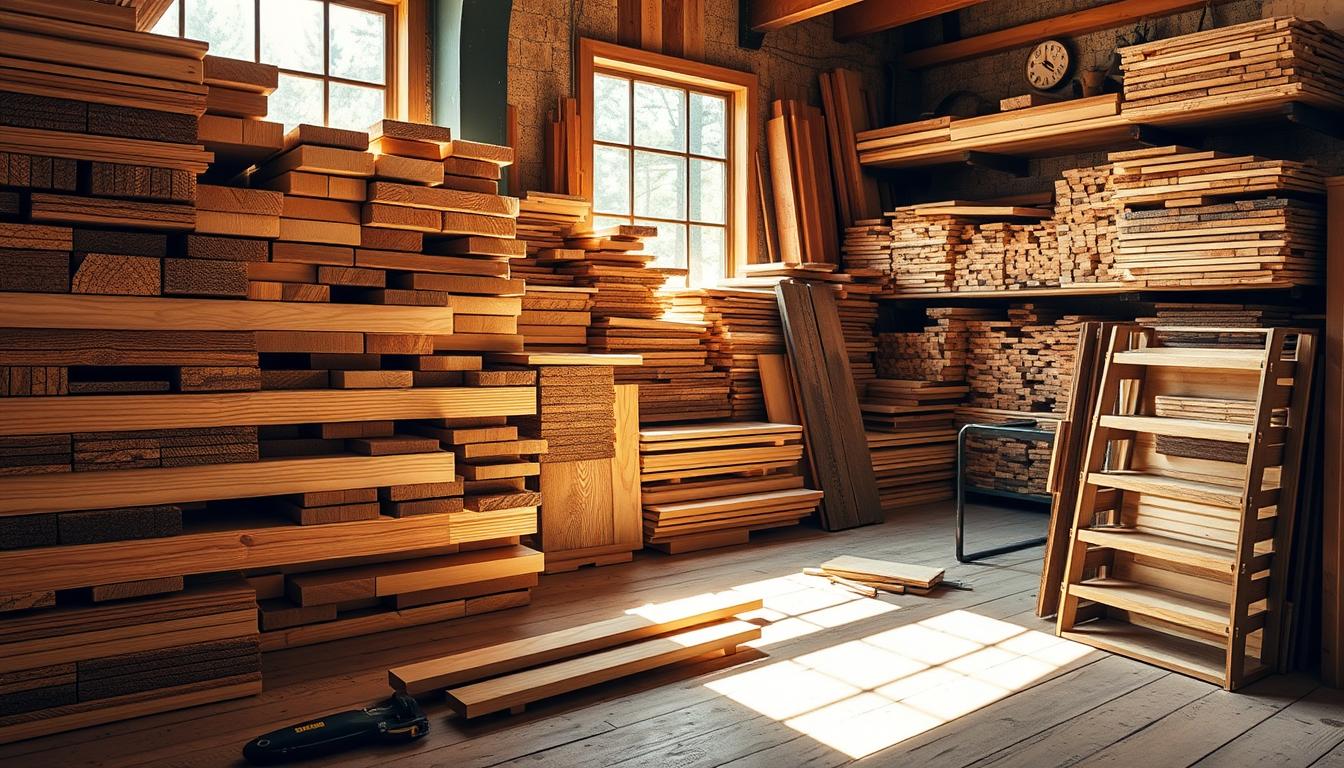Standing among towering lumber shelves, I think about the start of every creation. The smell of fresh cedar reminds me of my grandfather’s workshop. There, every project was a secret shared between wood and me. Now, I’m here to explore the world of lumber with you, sharing the stories each piece holds.
When creating, we often miss the small details. Like how lumber sizes change after drying and planing1. Or how hardwoods’ pores tell us about their grain. These details are key to a project’s success.
Exploring lumber’s heart, we find beauty and strength for every need. Let me guide you to the perfect lumber for your project, like Home Depot’s guide here.
Table of Contents
ToggleKey Takeaways
- Choosing the right lumber is key to your project’s success and longevity.
- Hardwoods and softwoods have different uses; knowing their traits is important.
- Lumber’s true size changes after drying and planing.
- Wood grading affects its look and strength.
- Choosing sustainable lumber helps the environment.
- Every piece of wood has a story and potential for creation.
>>Get 16,000 Woodworking Plans
Understanding Different Wood Types
When starting a wood project, like making furniture or building a deck, knowing the different types of wood is key. This knowledge helps us choose the right wood for our needs and protects the environment. It makes our projects better and more sustainable.
Hardwoods vs. Softwoods
Hardwoods and softwoods are two main types of wood. Hardwoods come from deciduous trees and grow slower, making them denser and more durable. They are great for furniture and flooring because of their fine grain and beauty.
Softwoods, from evergreen trees, grow faster and are lighter. They are perfect for building frames and outdoor structures because they are flexible and resist decay. Hardwoods are better at resisting fire because they are denser4.
Common Species of Hardwood
Species like oak, cherry, and walnut each have unique qualities for different projects. Oak is strong and versatile, used in flooring and dining sets. It comes in red and white oak, both known for their durability and beauty5.
Cherry wood is loved for its smooth grain and rich color. It ages well and is great for detailed furniture and decor. Walnut is sought after for its shock resistance and beautiful patterns, but it’s more expensive5.
Common Species of Softwood
Knowing the benefits of each wood type helps us choose the best for our projects. Whether we pick hardwoods for their density or softwoods for their flexibility, we make informed, sustainable choices. This way, our building practices are both strong and beautiful.

Characteristics of Wood
Wood’s qualities affect its use and look, making it popular in many areas. Knowing these traits helps pick the right wood for projects, like building or making furniture. Let’s explore the main features that make wood useful and beautiful.
Density and Strength
Wood’s density varies, showing its strength and how it handles stress and weather. Hardwoods like oak and mahogany are denser, making them strong and good for furniture and building. They weigh between 300 to 900 kg per cubic meter when dry, showing their durability7.
Specific gravity, similar to density, shows wood’s uniform strength. For example, Douglas fir has a specific gravity of about 0.45, showing its solid structure7.
Grain Patterns
Wood grain patterns add beauty and affect how wood is worked. Each type has its own pattern, from wavy to straight, giving unique textures and looks. These patterns are key in decorative uses and shape the look of wood products7.

Color Variations
Wood’s colors, from pine’s whites to cedar’s reds, are important in choosing it for projects. These colors set the mood of a space and match other design elements. Wood’s wide range of colors makes it great for both looks and function in building and decorating.
In summary, wood’s features, like density, strength, grain, and color, guide its use in different projects. These qualities add to wood’s beauty, usability, and performance, making it essential in both building and decoration.
Popular Wood Types for Furniture
In my journey exploring various furniture wood species, some options have proven exceptionally popular. They are favored for their durability and the beautiful finishes they lend to the products. Let’s delve into some favored types:
Oak
Oak wood is highly valued in furniture design for its strength and beauty. It has a Janka rating of 1290, making it very durable. This makes it perfect for long-lasting pieces like dining tables and hardwood flooring8. With around 90 species in North America, oak offers a wide range for different styles9.
Maple
Cherry
Pine
Pine has a lighter color and softer wood, making it appealing in its own way. With a Janka hardness score of around 500, it’s less durable than hardwoods. However, it’s great for furniture that won’t get a lot of use8. Its easy staining and painting make it versatile for customized projects.
Knowing about these wood species and the right wood finishes can greatly improve furniture’s look and lifespan. It ensures each piece not only looks good but also lasts through daily use.
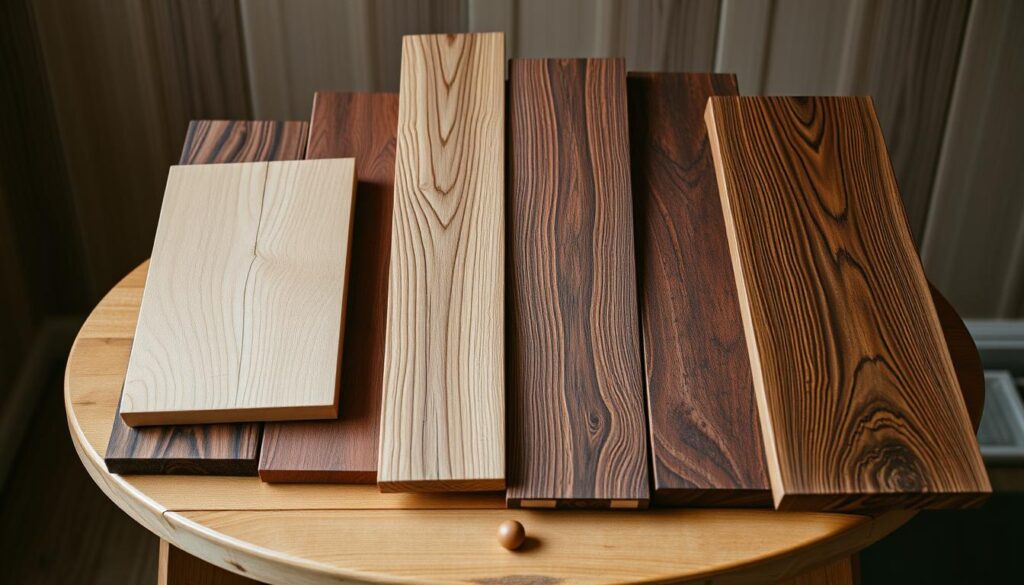
Wood Types Used in Construction
Choosing the right wood for construction is key for both durability and looks. Each wood type has its own special qualities. These are perfect for different parts of a building.

It’s important to know what each wood type can do. This helps builders pick the best materials for their projects. Whether it’s for support, outdoor use, or inside looks, the right wood makes a big difference.
>>Get 16,000 Woodworking Plans
Pressure-Treated Lumber
For projects needing to last long and fight off decay and pests, pressure-treated lumber is great. It’s treated with chemicals to protect it from the environment. This makes it perfect for outdoor things like decks and fences.
Cedar
Cedar wood is loved for its beauty and ability to resist decay. It’s often used for things like paneling, roofing, and sidings. It smells nice and keeps insects away, making it great for closets and outside finishes.
Cedar is light but strong enough for many uses11.
Douglas Fir
Douglas fir is one of the strongest softwoods. It’s mainly used for framing and structural parts. It holds nails and screws well, making it reliable for tough jobs.
It also doesn’t bend or warp easily, which is why it’s chosen for buildings that need to last12.
Specialty Woods and Their Uses
Exploring specialty woods shows a wide range of unique timbers. Each is chosen for its special strengths and beauty. These exotic woods not only make projects look better but also show a perfect mix of nature and engineering.
Teak
Teak is known for being tough and water-resistant. It’s perfect for building boats and high-end outdoor furniture. Its natural oils and dense grain fight off decay and pests13.
It takes about 60 years to grow teak, making it rare and expensive13.
Mahogany
Redwood
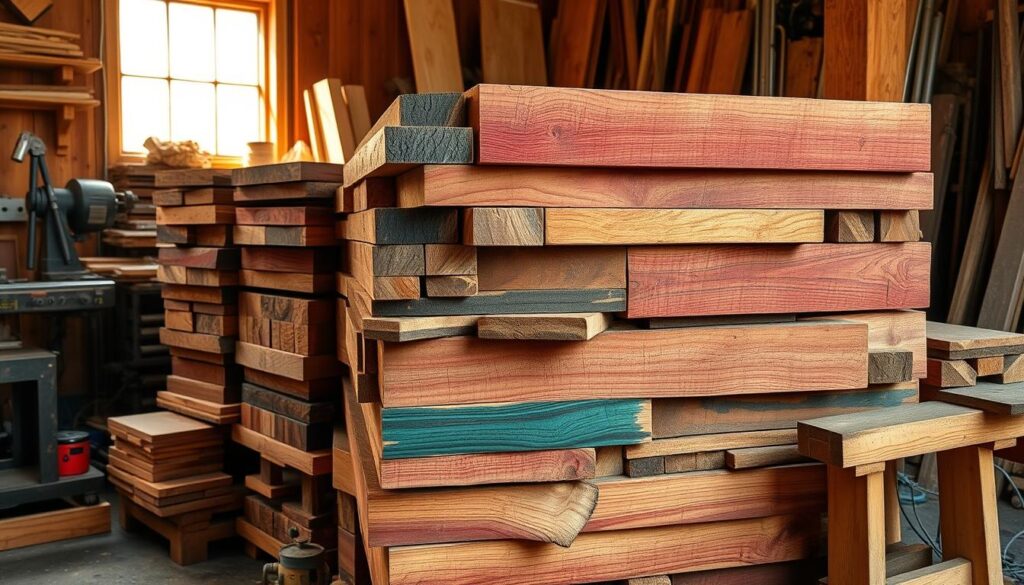
Using these exotic woods in projects makes them look better and last longer. As we care more about the environment, picking the right wood is key. It meets both design needs and eco-responsibility.
From teak’s water resistance to mahogany’s fine grain and redwood’s durability, choosing the right wood greatly affects a project’s look and function.
Selecting Wood for Outdoor Projects
Choosing the right wood for outdoor projects is key for looks and durability. Knowing the traits of different woods helps make a smart choice. This ensures your outdoor spaces last long and look great.
Weather Resistance
Durability
Maintenance
The wood you choose affects the project’s cost, how long it lasts, and upkeep. Picking quality lumber that fits your climate and needs makes your outdoor projects better and more rewarding.
>>Get 16,000 Woodworking Plans

Sustainable Wood Choices
Choosing sustainable forestry is key for those who care about our planet and wood’s beauty. It’s not just a duty; it’s a promise to future generations. Using sustainable wood in our projects helps the environment and adds natural beauty and strength.
Certified Wood Products
Opting for certified wood is a big step towards eco-friendly lumber choices. Look for the Forest Stewardship Council (FSC) and Programme for the Endorsement of Forest Certification (PEFC) labels. These ensure the wood comes from well-managed forests, which is vital for biodiversity and protecting endangered species19. Such practices value the environment and society as much as the economy20.
Reclaimed Wood
Reclaimed wood is a strong statement of sustainability and history. It comes from old buildings and barns, reducing the need for new wood. This saves natural resources and adds unique stories and beauty to new projects20. Its rustic charm is especially valued in furniture and décor, promoting sustainable use21.
Bamboo
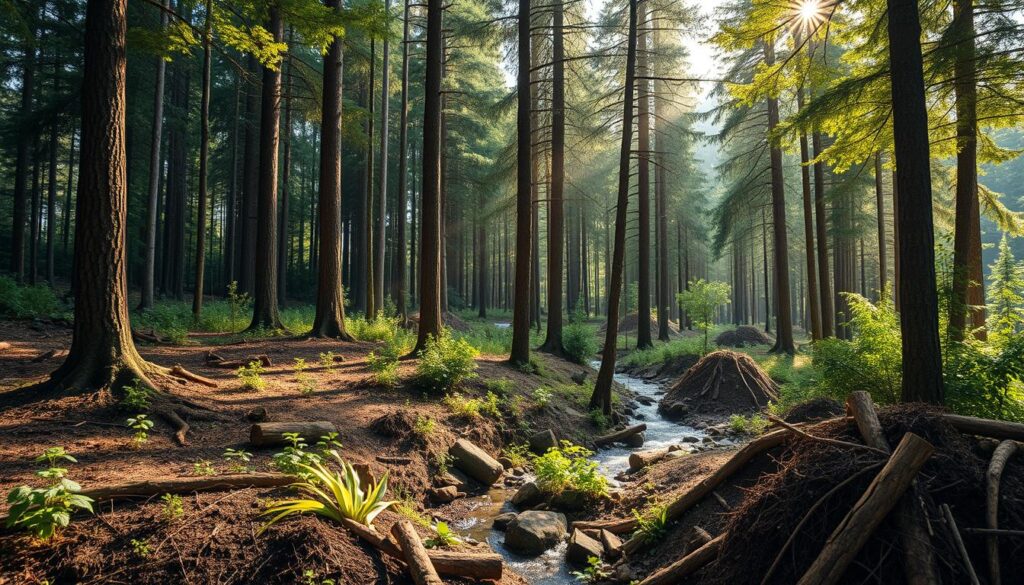
Switching to sustainable wood like certified, reclaimed, and bamboo is crucial for fighting climate change and living eco-friendly. Each choice we make shows our dedication to the planet, ensuring our forests stay healthy and diverse.
| Wood Type | Renewability | Typical Use | Benefits |
|---|---|---|---|
| Bamboo | 3-5 years | Flooring, Furniture | Highly renewable, strong |
| Reclaimed Wood | Varies | Furniture, Decor | Conserves resources, unique aesthetic |
| Certified Wood | Depends on certification | Varied uses | Sustainable sourcing, supports biodiversity19 |
Wood Types for Crafting and DIY Projects
Choosing the right wood is key for DIY woodworking success. Whether making furniture, decorations, or small details, knowing wood types matters. We’ll look at Plywood, MDF, and Balsa for crafting and DIY projects.
Plywood
Plywood is great for DIY woodworking because it’s strong and easy to work with. It’s made of wood layers bonded together. This makes it strong and even, perfect for projects needing uniformity.
Plywood is also easy to cut and shape. It’s great for furniture and small crafts. Plus, it holds screws and nails well, making it perfect for shelving22.
MDF
Medium Density Fiberboard (MDF) is ideal for detailed DIY projects. It’s made from wood fibers, resin, and wax, pressed into panels. Its smooth surface is perfect for painting and fine finishes on cabinets and decorations.
But, MDF is sensitive to moisture. Use it carefully in areas where it might get wet23.
Balsa
Balsa wood is known for its lightness and ease of use. It’s easy to cut, carve, and shape. This makes it great for model-making and lightweight crafts.
Despite being soft, Balsa is durable. It’s often used in educational projects and DIY crafting24.
Choosing the right wood is crucial for your project’s success. Consider each wood’s characteristics and match them to your DIY needs for the best results.
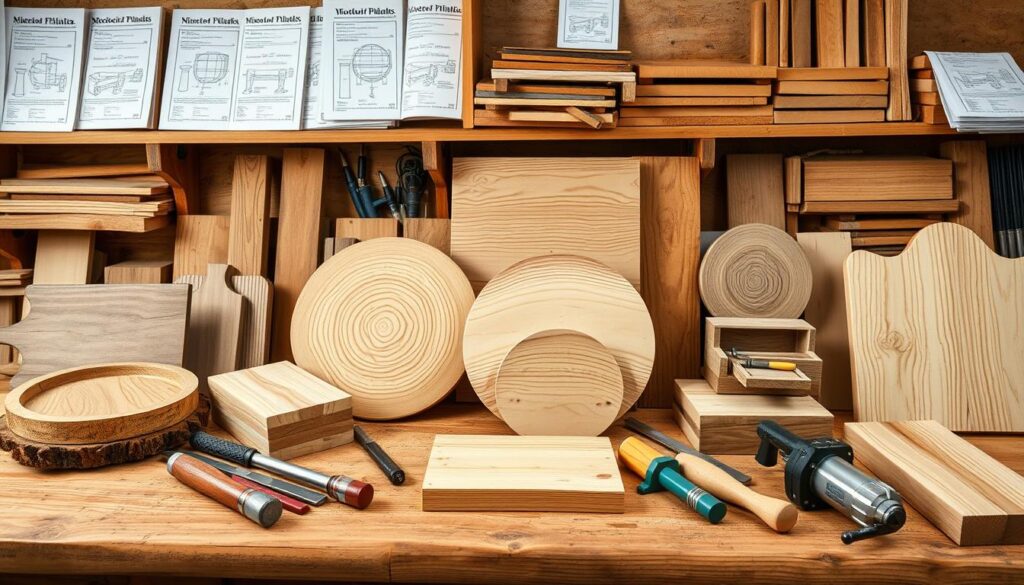
Understanding Wood Grades
When picking wood for a project, knowing about wood grading systems is key. It helps ensure you get the right lumber quality for your needs.
What Wood Grading Means
Common Grading Standards
In hardwoods, FAS grade means the wood is big and long. It must have 83-1/3% clear face cuttings, with sizes like 4″ x 5′ or 3″ x 7′26. Softwood grading is different, with Select appearance lumber in Grades A-D for looks that matter25. For example, Grade A has no visible defects, perfect for top-notch projects27.
Impacts on Price
Knowing these grading standards is not just about looks. It’s also about how long the wood will last in different places27.
Tips for Choosing the Right Wood
Choosing the right lumber is key for any project. It’s important to know the wood species’ characteristics. For heavy or often-used projects, hardwoods like hickory or hard maple are best. They are very hard28.
For lighter or decorative projects, softer woods like balsa or poplar work well28.
>>Get 16,000 Woodworking Plans
Always budget extra for mistakes or repairs, especially with expensive woods.
Getting advice from experts can really help. They know a lot about different woods and can find the perfect one for you. Sustainable options like bamboo or certified white ash are also good choices29. They come from well-managed forests and help the environment.
With these tips, you can make smart choices. You’ll get materials that look good, work well, and fit your budget.
FAQ
What are the main differences between hardwoods and softwoods?
Hardwoods come from deciduous trees and are denser and more durable. They are great for furniture and flooring. Softwoods, from coniferous trees, are lighter and easier to work with. They are often used in construction and for outdoor projects.
What are some common hardwood species and their uses?
Oak is strong and moisture-resistant, making it perfect for furniture and flooring. Maple is versatile and easy to stain. Cherry has an exquisite finish and color. Walnut is durable and adds depth to furniture.
What are some common softwood species and their uses?
Pine is affordable and versatile, great for many projects. Cedar has a pleasant scent and resists decay. Douglas fir is strong and used in framing and construction.
How do density and strength affect the choice of wood?
Density and strength determine how well wood can handle weight and stress. Denser woods like hardwoods are best for heavy furniture and construction. Lighter softwoods are good for interior moldings and frames.
Why are grain patterns in wood important?
Grain patterns add to a wood’s beauty and workability. They can make a piece more visually appealing and affect how it’s cut and assembled.
How do color variations in wood influence a project?
Color variations can shape the style and design of a project. Cherry darkens beautifully over time. Pine takes stains and paints well, offering versatility.
What are some popular wood types used for furniture-making?
Oak, maple, cherry, and pine are favorites for furniture. Oak is durable and water-resistant. Maple is adaptable and takes stains well. Cherry offers a luxurious finish. Pine is cost-effective and paintable.
What wood types are commonly used in construction?
Pressure-treated lumber, cedar, and Douglas fir are common in construction. Pressure-treated lumber resists decay. Cedar is durable with a pleasant scent. Douglas fir is strong for framing and structural components.
What specialty woods are used for specific applications?
Teak is used for boat building and luxury furniture. Mahogany is favored in high-end furniture for its grain and decay resistance. Redwood is chosen for its beauty and rot resistance in outdoor projects.
How do I select wood for outdoor woodworking projects?
Look for weather resistance, durability, and maintenance level. Teak, cedar, and redwood naturally resist rot and decay. Pressure-treated lumber is treated for longevity and structure.
What are some sustainable wood choices for my projects?
Choose certified wood products, reclaimed wood, and bamboo. Certified woods come from responsibly managed forests. Reclaimed wood reduces the need for new timber. Bamboo is fast-growing and renewable.
What kinds of wood are best for crafting and DIY projects?
Plywood and MDF are versatile and easy to work with. Balsa wood is lightweight and great for model making and small crafts.
What does wood grading mean?
Wood grading assesses the quality of lumber. It looks at strength, appearance, and defects. Higher grades are freer from defects and are often preferred for appearance.
How do wood grading standards vary between hardwoods and softwoods?
Hardwood grading standards like FAS prioritize clear, smooth boards. Softwood grades like C Select focus on features like knot prevalence. They are categorized based on their intended use.
Why is understanding the impacts of wood grades on price important?
Grading impacts the price of lumber. Higher-grade woods with fewer defects are usually more expensive. Knowing this helps balance cost-efficiency with quality for your project.
How should I consider my project needs when choosing the right wood?
Consider the structural requirements, desired aesthetics, and the wood’s properties. This will guide you to select the wood best suited for your project.
What tips can you offer for budgeting for wood in a project?
Account for the type, quantity, and grade of lumber needed. Anticipate extra costs for potential mistakes or future repairs. This will help you allocate your budget effectively and avoid surprises.
Why is seeking professional advice beneficial when selecting lumber?
Professionals have in-depth knowledge of wood species, applications, and grades. Their advice can be invaluable in making an informed choice. It ensures the wood matches your project’s needs and stays within budget.
Source Links
- Wood and Treated Lumber Buying Guide | Lowe’s – https://www.lowes.com/n/buying-guide/lumber-buying-guide
- 11 Different Types of Wood and Their Uses – https://www.maramani.com/blogs/home-design-ideas/different-types-wood?srsltid=AfmBOoqShgDv8fPL1zpj14B5mbhVCmtE5IB2Dyor_BrDvofNZPitc2AS
- Guide to Lumber Terms: Understanding Wood Types and Dimensions – https://www.thisoldhouse.com/woodworking/21015421/the-language-of-lumber
- 27 Different Types Of Wood And Their Uses – https://vinawoodltd.com/blogs/news/types-of-wood
- A Guide To Wood Types – https://www.homesdirect365.co.uk/blog/2020/07/a-guide-to-wood-types/
- The Different Types of Wood and Their Uses in Design and Construction – https://www.homedsgn.com/types-of-wood/
- Wood – Strength, Density, Hardness | Britannica – https://www.britannica.com/science/wood-plant-tissue/Properties-of-wood
- Different Types of Wood For Furniture Making – https://www.sierralivingconcepts.com/blog/different-types-of-wood-used-in-furniture-making/?srsltid=AfmBOoqkIcGx25zYGXrAREUKBRZO6OW0xVQL7OvvpxlbnQKqJYt4iM0f
- 10 Types of Wood for Furniture – https://carpenterjames.com/blogs/news/types-of-wood-for-furniture?srsltid=AfmBOoqgDP3-EXWiL0aBB3z1w7Y_-zqjlOarShtFxZ0ImQT3uc7t96S-
- Different Types of Wood for Furniture [Picture Guide] – Cabinfield Blog – https://www.cabinfield.com/blog/different-types-of-wood-for-furniture-picture-guide/?srsltid=AfmBOoo4BNzU0guS9Io2h9KpwlyL2xKmKZtO_GZ3hP-M1AJ1p7k-j7fb
- Popular Types Of Wood For Construction | Ridout Lumber – https://ridoutlumber.com/popular-types-of-wood-for-construction/
- Different Types of Wood & Their Uses | Wood Supply Research Institute – https://wsri.org/different-types-of-wood-their-uses/
- WOODWORKING 101: A GUIDE TO CHOOSING THE RIGHT TYPE OF WOOD – Dragonfiretools – https://dragonfiretools.com/blogs/workbench-wisdom-blog/woodworking-101-a-guide-to-choosing-the-right-type-of-wood
- Wholesale Building Materials: What Are the Different Types of Specialty Wood? – https://www.idapac.com/wholesale-building-materials/what-are-the-different-types-of-specialty-wood/
- Wood Types, Characteristics and Identification Guide – https://www.woodassistant.com/
- 9 mighty woods for outdoor projects – https://www.woodmagazine.com/materials-guide/lumber/outdoor-lumber
- The Best Wood for Outdoor Projects – https://northcastlehw.com/blogs/wood/the-best-wood-for-outdoor-projects?srsltid=AfmBOoppQ1ymwrXr-VxrcjdHQKkabX0og84cp3XCcSSUFY8cn1GOHzSh
- 9 Wood Species Best for Outdoor Projects – https://www.tablelegsonline.com/blog/9-wood-species-best-for-outdoor-projects/?srsltid=AfmBOopQgTtJ8jK6foWliMSNp1o5hG5i_Oo74Y_HCmT-oQt9BuREs_Yk
- Exploring the Most Sustainable Wood Types: An In-Depth Guide – https://hfswitzerland.ch/sustainable-woods/
- Top Sustainable Wood Types for Eco-Friendly Furniture — Sustainable Review – https://sustainablereview.com/best-eco-friendly-wood-types-for-sustainable-furniture/
- 10 Most Sustainable Types of Wood? A Life-Cycle Analysis | Impactful Ninja – https://impactful.ninja/most-sustainable-types-of-wood/
- DIY Basics: wood for DIY projects – https://www.lemonthistle.com/diy-basics-wood/
- Choosing the Right Wood Species for Your DIY Projects – https://hi-spec.com/blogs/news/choosing-the-right-wood-species-for-your-diy-projects
- The Ultimate Guide to Buying Wood for DIY Projects – https://pineandpoplar.com/buying-wood-for-diy-projects/
- Lumber Grades Explained – Zeeland Lumber & Supply – https://www.zeelandlumber.com/lumber-grades-explained/
- The Basics of Hardwood Lumber Grades [custom wws] – https://www.woodworkerssource.com/hardwood-lumber-grades.html?srsltid=AfmBOopN8iunOe-Npha4BZFa7jxtU2xIKEnW8AaOQEwcm95-OysJET9n
- Understanding Wood Grades — JJ Benson Inc – https://www.jjbensoninc.com/blog/understanding-wood-grades
- How to Choose the Right Type of Wood for a DIY Project – Bessemeter – https://www.bessemeter.com/blog/how-to-choose-the-right-type-of-wood-for-a-diy-project/?srsltid=AfmBOorA7sE1Q_62skvASSfYEb8L_PSOe1hws3eA-8o1NcOvVEUBV5Yb
- How to choose the perfect wood species for your DIY project | The RE Store – https://re-store.org/how-to-choose-the-perfect-wood-species-for-your-diy-project/

